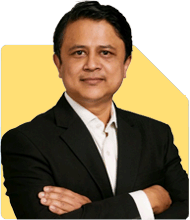Mayank Rautela | Answer |Ask -Follow
HR Expert - Answered on May 18, 2022
A management graduate from the Symbiosis Institute of Management Studies with a master's degree in labour laws from Pune University, Rautela has over 20 years of experience in general management, strategic human resources, global mergers and integrations and change management.... more

Dear Mayank Sir,
I am facing a difficult problem both personally and professionally.
Last year, I took the decision to move back home, which is in a small town, because both my parents had survived COVID but have been facing major health issues since then.
I am their only child.
As a result, I had to leave a job where my prospects were very good and I was enjoying my work very much. Also, I was living in a big city, independent of my parents whom I love very much.
It is a struggle to be back at home with them. They still treat me like a small child with advice and questions at every step.
Workwise too, the job is a huge stepdown and the money, though decent, is less that what I used to earn. Responsibilities and challenges, which I used to enjoy, are less too.
I have to stay here for one more year at least before I can make plans to move out again.
The stress from home is spilling out at my job and the irritation at work is spilling out at home.
How do I handle this? Am going crazy.
Please help.
Hi.
I appreciate the fact that you sacrificed your job to take care of your parents.
Ideally, you should go back to a larger city and restart your career. I am sure your past employer would be open to taking you back.
If that is not possible, then you need to have a candid discussion with your parents and make them understand that their constant involvement in your life is not acceptable.
They may be doing it out of love but, since it is negatively impacting you, they need to give you space.
Please don’t change your job in your hometown as that will further complicate your situation.
You may like to see similar questions and answers below
Anu Krishna |1745 Answers |Ask -Follow
Relationships Expert, Mind Coach - Answered on Oct 06, 2020
Anu Krishna |1745 Answers |Ask -Follow
Relationships Expert, Mind Coach - Answered on Oct 06, 2020
Mayank Rautela | Answer |Ask -Follow
HR Expert - Answered on Aug 24, 2022
Radheshyam Zanwar |6735 Answers |Ask -Follow
MHT-CET, IIT-JEE, NEET-UG Expert - Answered on Dec 06, 2025
Dr Nagarajan J S K |2576 Answers |Ask -Follow
NEET, Medical, Pharmacy Careers - Answered on Dec 06, 2025
Mihir Tanna |1090 Answers |Ask -Follow
Tax Expert - Answered on Dec 06, 2025
Ramalingam Kalirajan |10872 Answers |Ask -Follow
Mutual Funds, Financial Planning Expert - Answered on Dec 06, 2025
Radheshyam Zanwar |6735 Answers |Ask -Follow
MHT-CET, IIT-JEE, NEET-UG Expert - Answered on Dec 06, 2025
Radheshyam Zanwar |6735 Answers |Ask -Follow
MHT-CET, IIT-JEE, NEET-UG Expert - Answered on Dec 06, 2025
Radheshyam Zanwar |6735 Answers |Ask -Follow
MHT-CET, IIT-JEE, NEET-UG Expert - Answered on Dec 06, 2025
Dr Dipankar Dutta |1837 Answers |Ask -Follow
Tech Careers and Skill Development Expert - Answered on Dec 05, 2025
Dr Shyam Jamalabad |108 Answers |Ask -Follow
Dentist - Answered on Dec 05, 2025
Dr Shyam Jamalabad |108 Answers |Ask -Follow
Dentist - Answered on Dec 05, 2025



























